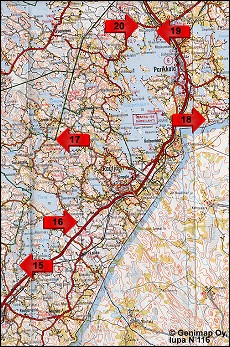
|
|
Site Map: Sites 15-20
|
18. Cup stone from Silvu in Parikkala
A cup stone is a stone or rock in which shallow cup-like indentations of on average 5-10 cm have been made. A stone may have one or more cups. According to tradition, cup stones were sacrificial stones. They are connected to the Iron Age and the farming culture of the time of recorded history.
The cup stone from Silvu in Parikkala was discovered in the 1950s. It is a large, approximately 4 x 4 x 6 metre erratic boulder. Eight cups have been ground out of its surface. The cups are 6-11 cm in diameter and about 2-9 cm deep. The stone is located in the upper part of a former field on a hill that slopes down to the west.
Over 350 cup stones have been found in Finland. As antiquities, the cup stones are enigmatic. In popular tradition they have been assigned many meanings. Cup stones are sometimes linked to serving the dead, for some of them are located near Iron Age burial grounds. In folklore, cups hewn into the stone served as food and drink vessels for the bird-shaped souls of the dead. Fertility cults used the cups for sacrificial offerings of grain and milk to increase good fortune in harvest and hunt. In folk poetry, cup stones, "stones of pain", are used to drive away sickness. Some think the cup stones also indicated land ownership. Cup stones have been used for hundreds of years, and their meaning may have changed over time.
It is difficult to date the cup stones. Their use probably began during the Iron Age and continued into the time of recorded history, in some places even up to the 1900s. Today cup stones are found near old villages and fields. Other kinds of sacrificial stones are also found in Finland.
Driving directions: From Highway 6, take road number 4012 and drive 2.6 km toward the Kolmikanta border crossing point. Turn right after the open field and continue 1.5 km on the main road. A path to the cup stone starts from the right side of the road. The path is about 300 metres long. No parking available.
